|
 __________________________________________________________ __________________________________________________________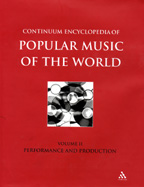 Sanza Sanza
"Mbira"
Introduction
The generic terms mbira
or thumb piano are used to indicate a percussion instrument
of African origin. It consists of a wooden board or box
with strips of metal or wood attached in such a way that
the player's thumbs or fingers can pluck the metal strips
to produce a rhythmic melody. Mbira are made from
an assortment of materials, such as wood, metal gas and
insecticide cans, gourds and coconut shells, and in a great
variety of sizes, shapes and types, and they exist as acoustic
or electric instruments. The number of traditional African
types alone would take an entire book to detail, and a diverse
assortment of these instruments can be found in the Western
world as well.
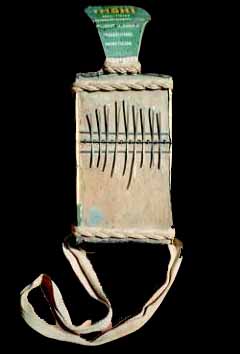
Sanza
of Collin Walcott (Kondi from Sierra Leone)
Nomenclature
The terms "thumb
piano" and "finger piano" are names in the
West for the instrument and yet, at the same time, they
are the most inappropriate from an African perspective (also
incorrect are African piano, African nail violin, hand piano,
and Kaffir piano). Ethnomusicologists use another term that
places all these instruments in a single generic category:
"lamellaphone" (also lamellophone) designates
any instrument with plucked keys (or lamellae) attached
to a soundboard, with the possible addition of a resonator.
What is called a "thumb piano" or "finger
piano" is often a specific instrument from an African
culture. Such instruments may be used, in an African traditional
setting, in ritual ceremonies, such as those performed by
the Shona people of Zimbabwe. Renaming the instrument for
Western purposes is akin to calling a concert violin a "fiddle."
Nevertheless, "thumb piano" and "finger piano"
are names found on many recordings and in many publications.
To complicate matters further, on Western recordings a generic
name like mbira, kalimba, or sanza
may appear, but it is more often used as an exotic name
than as an identifier of a specific African instrument.
The term "kalimba" was popularized by
the African music researcher Hugh Tracey (from England).
Traveling to Zimbabwe in the 1920s (then known as Rhodesia),
Tracey was attracted to the Shona mbira and eventually
made an international version by the 1960s that he called
kalimba. Although the term "mbira"
is a Shona term meaning an instrument specific to their
culture, the term is used in this article generically as
is often the case in non-African popular musics. Following
is a list of mbira-type instruments (with their
usual number of keys) and the country where they are found.
All of the instruments listed are used in musics native
to Africa or the African Diaspora. The list demonstrates
the number of instruments of similar appearance and construction
that are found in different places and often with only slightly
different names.
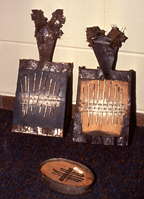
Various
Sanza
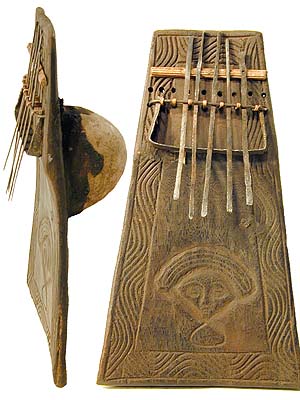
Lamellaphone
of Chokwe People in Gabon
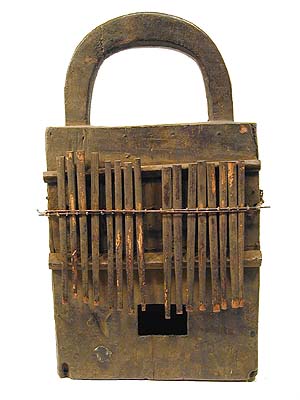
Lamellaphone
of Bamana People of Mali
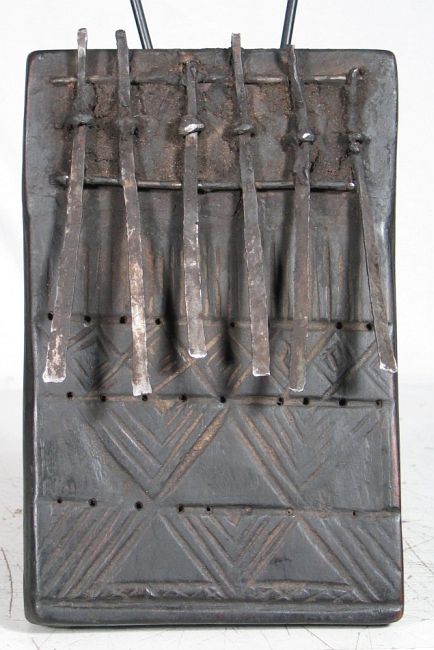
Lamellaphone
of Lwena People of Angola
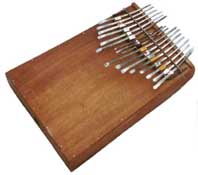
Kadongo
of Uganda
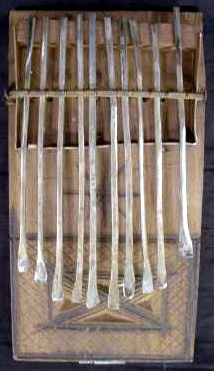
Kalimba
of Zambia
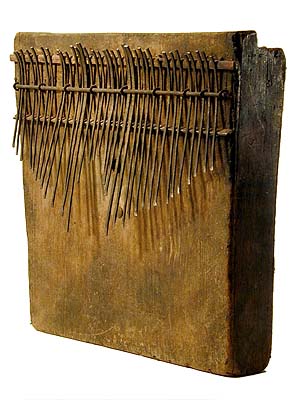
Ilimba
of Gogo People of Tanzania
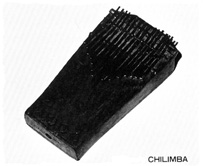
Chilimba
of Dr. Hukwe Ubi Zawose of Tanzania
AFRICA
sanza (21 metal
or 18 raffia lamellae), mbo nggo (8 raffia lamellae),
mboton, timbrh—Cameroon; sanza
(9-12), sanzi (9-12)— Cameroon and Central
African Republic; kalimba, lukembe—Congo;
fang (6), likembe, kisansi, lukembe
(10 wooden lamellae), luba (4), mbanja
(8), yombe (10), zande (7)—Democratic
Republic of the Congo (formerly Zaïre); tom—Ethiopia;
aprempensuah—Ghana; bonduma, gbelee,
kongoma—Liberia; kalimba, malimba—Malawi;
danda, chisanza (22), malimba
(26), tomboji, utee—Mozambique;
jidiga—Niger; agidigbo (5), akpata,
sologun, ubo—Nigeria; mbila
dza madeza (27), mbila tshipai (11-18)—
Republic of South Africa; bundoma (9, 10),
kondi (9), kongoma (3), kututen (9,
11)—Sierra Leone; afosangu—Sudan; chilimba
(15), ilimba (36, 55, 66-72), malimba—Tanzania;
kadongo/budongo (plural) (10, 14, 15, 17),
lukeme—Uganda; kalimba (14), luvale
(13)—Zambia; hera (26, 34), karimba
(15, 17, 19), matepe (25, 29), mbira dza vadzimu
(22, 23, 24, 25, 26, 27), mbira dza vaNdau (29,
30, 34), munyonga (47, 52, 56), ndimba
(15, 17), njari (29, 36), nyonga nyonga
(15), nyunga nyunga (15)—Zimbabwe.
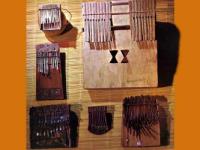
Various
African Lamellaphones
THE AFRICAN DIASPORA
laongo bania, madimba de Btsche,
marimba (16), sanza—Brazil; marímbula
(7)—Colombia; marímbula (4-7)—Cuba;
marimba, marímbola (5-6)—Dominican
Republic; malimba (4-7)—Haiti; rhumba
box (5-7)—Jamaica; marímbula
(3-5)—Martinique; marímbula (6), marimbol—Mexico;
Puerto Rico; banja (5), box bass (5-6),
marímbula (5-6)—Trinidad and Tobago;
marimba brett—United States; quisanche—Uruguay;
marímbola (5-6)—Venezuela.
In addition to the traditional instruments found in Africa
and the African Diaspora, more generic versions, based on
those of traditional African design, have been made by Western
instrument makers. Makers in North America often give the
instrument the generic name of thumb piano, mbira,
or kalimba. A Western innovation is the purely
electric mbira (the "e.mbira"), made
by Lucinda
Ellison (and also those made by David
Bellinger), which is constructed in a similar fashion
to the solid-body electric guitar, with internal pickups
under the bridge and a jack to plug into an amplifier. Fully
electric mbira dza vadzimu are designed and built
in the USA by Dan Pauli (including mbira dza vadzimu
with extra keys, chromatic mbira, and electric
bass mbira dza vadzimu that are much lower than
traditional Shona instruments). Other North American acoustic
makers include Ryphon
Gray, Scotty Hayward,
Kevin Nathaniel,
and Leonard Nicoll. Portuguese maker Nuno
Cristo has developed an entirely bamboo mbira dza
vadzimu tuned an octave lower than Shona mbira.
Perhaps the most original designer of modern lamellaphones
in the USA is Bill Wesley who, along with Patrick Hadley,
has designed a completely new type of lamellae layout and
an acoustic - electric instrument called the array
mbira (120 lamellae, four octaves, chromatic).
One difference between African and Western lamellaphones
is that the former most often have shells, metal rings or
bottle caps attached which make a buzzing sound when the
keys are plucked—a desired African aesthetic. Western-made
lamellaphones often do not have buzzers attached, which
gives the instruments a plainer sound but makes recording
in popular music less problematic.
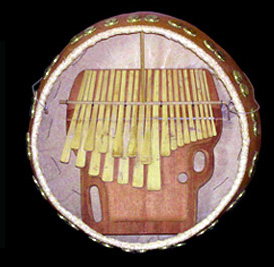
Bamboo mbira dza vadzimu
made by Nuno Cristo
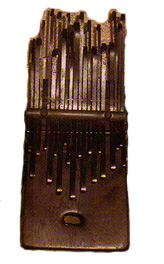
North American kalimba
design by Ryphon Gray & Scotty Hayward
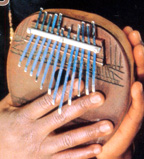
Kalimba
of Samite of Uganda
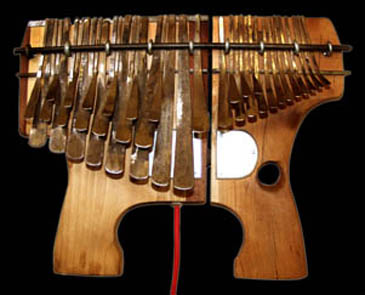
Solid body
stereo electric mbira dza vadzimu by Dan Pauli
(37 lamellae)
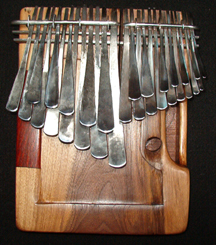
Chromatic
mbira by Dan Pauli (29 lamellae)
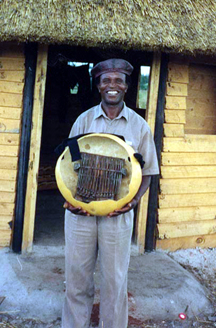
David Gweshe
with munyonga
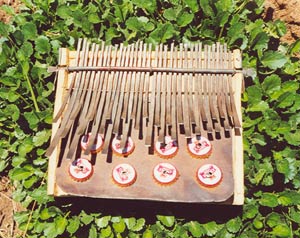
Mbira
DzaVaNdau from Southeastern Zimbabwe
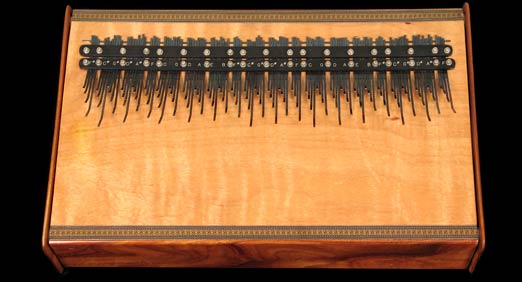
Bill Wesley's
array mbira, 120 lamellae, four octaves, chromatic,
electric pick up
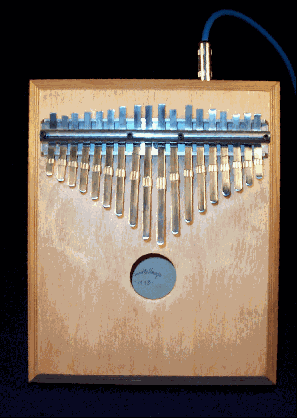
David Bellinger's
electric kalimba
Tuning and Technique
Tuning represents another
important difference between African and Western instruments.
African instruments use mainly two types of scales for lamellaphones—a
five-pitch scale and a seven-pitch scale—although
other types may be found as well. Tuning in Africa is regional,
which means that a tuning from one particular area might
not match exactly with a tuning from another area if the
scale intervals were compared. This is part of an African
aesthetic in music—tuning varies across the continent
and the variations add to the beauty of an area's music.
In contrast, tuning in the West has become standardized,
and variations are considered 'out of tune' so the pentatonic
and heptatonic scales used on Western made instruments have
all been standardized. A few different heptatonic scales
are played on the Shona lamellaphones in Zimbabwe, such
as on the mbira dza vadzimu. These scales may appear
to be major (Dambatsoko), natural minor, Mixolydian
(Nyamaropa), or Phrygian (Gandanga), with
some interval differences from Western scales (see mbira
tunings).
Another difference between
African and Western keyed instruments is in how the keys
are arranged. A Western keyboard (as on the piano) is arranged
from lowest pitches to highest from the left to the right.
Most lamellaphones are arranged with the lowest key in the
center, and the player alternately plucks right and left
or vice versa (depending on how the keyboard has been set
up) to ascend the scale. The Shona mbira dza vadzimu
are an exception—they make use of three manuals on
a single instrument. The left side of the instrument is
played primarily with the left thumb and has two rows of
seven keys in octaves arranged from the center to the left
for ascending, while the right side, which is played with
the right thumb and forefinger, is arranged from the center
to the right for ascending.
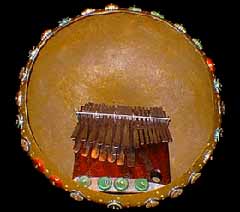
Mbira
dza vadzimu of Zimbabwe
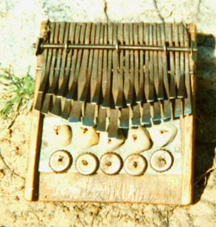
Njari
of Zimbabwe
The basic technique for
playing the mbira involves plucking the keys, or
lamellae, with the fingertips and fingernails. Some techniques
involve playing with the index, middle and ring fingers
of each hand, as on the Nigerian agidigbo while
the Cameroonian sanza makes use of all of the fingers
but no thumbs. Other techniques involve the use of the thumbs
plucking down on the keys while the index fingers pluck
up from beneath them, as on the mbira dza vadzimu
from Zimbabwe (often metal finger picks are placed on the
tips of the thumbs and index finger for ease of play). The
thumbs are used to pluck the keys of the sanza
in the Central African Republic. The material used for the
keys varies: some are made from a heavier, stiffer metal
that requires the player to have a longer thumbnail to play
comfortably, while others may be of a softer, more flexible
metal that makes plucking with the fingertip comfortable.
The mbira can be played melodically by plucking
out a melody on the keys, or in a rhythmic fashion by plucking
a pattern on one side of the keyboard while a pattern that
fills in between the first is plucked on the other side.
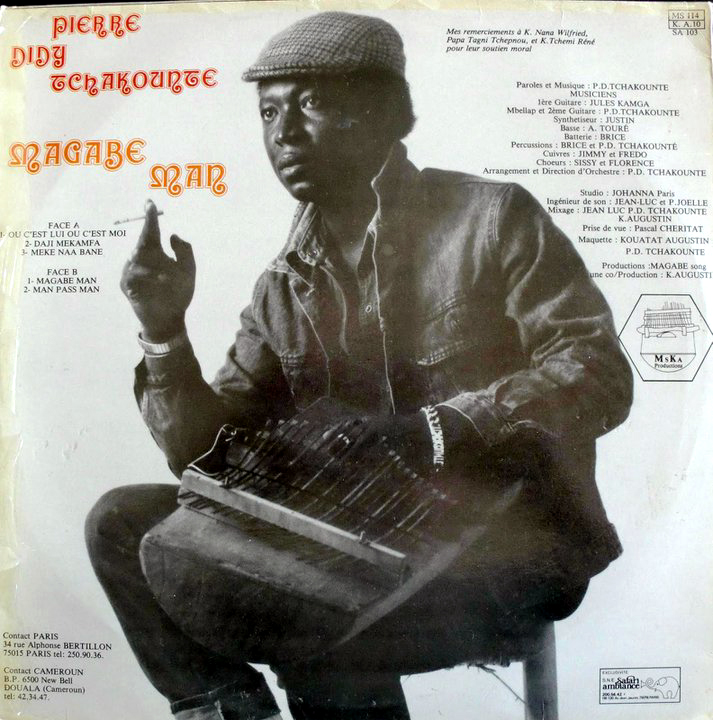
Pierre Didy
Tchakounté with sanza from the mangambeu
LP cover Magabe Man
Use in Popular Music
In a very broad sense,
two types of popular music make use of mbira: popular
musics of Africa and parts of the African Diaspora, and
Western popular musics (non-African). In Africa, popular
music can be considered an urban phenomenon. That is to
say, urban situations make possible a detribalized zone
of cultural interaction in which strict adherence to specific
cultural traditions may not operate. Urban musics in Africa
are the result of the combining of local traditional elements
with Western influences, such as the radio, the microphone,
and music business, and instruments like the electric guitar,
saxophone, trumpet, electric bass, keyboards and drumset.
The urban music of the Shona People of Zimbabwe, known as
chimurenga (uprising), involves a mixing of mbira
music with rock, Christian hymns, jazz and various types
of traditional songs. This music came about as a result
of the uprising of indigenous Black Africans against White
European colonialism. The uprising began in the 1890s and,
by the 1970s, fully Western influences (in terms of the
use of electric instrumentation) in chimurenga
songs had become evident. After failing to win a music competition
to rock artists, Thomas Mapfumo and the Blacks Unlimited
formed in 1977 and started incorporating aspects of traditional
Shona music, such as mbira dza vadzimu patterns
played on multiple electric guitars as well as up to three
mbira players including Chartwell Dutiro. Another
important Zimbabwean artist is Ephat Mujuru with the Spirit
of the People, whose music involves the use of electric
Shona mbira. Cameroonian Pierre
Didy Tchakounté featured both the traditional wooden-keyed
sanza and a more modern metal-keyed version in
his mangambeu urban music recordings from the 1970s.
Hukwe Ubi Zawose of Tanzania may be viewed as a
neo-traditionalist who has rebuilt his instrument, the ilimba,
to include between 66 and 72 keys tuned in just intonation,
many of which are used for ‘sympathetic’ resonance.
Another African musician, Francis Bebey, has studied various
musical traditions in Africa and mixes them together on
his recordings, often including lamellaphones. The music
of the Orchestre Bana Luya (children of the Baluba people)
in the Democratic Republic of the Congo (DRC formerly Zaïre)
also features an electric lamellaphone. An important figure
in early Zaïro-Congolese urban music was Antoine Moundanda
who formed the band Likembé Géant in the early
1950s that used three giant likembe and played
Congolese rumba, polkas, and traditional music
and recorded many LPs for the Ngoma label. Konono N°1
is a modern ensemble from the DRC that performs on self-made
electrified likembes developed by Mawangu Mingiedi.
All of these recorded examples of African uses of lamellaphones
in urban music are from the past 50 years, but one of the
earliest examples of the use of these instruments in recorded
popular music is from the African Diaspora.
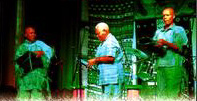
Antoine
Moundanda (center) & Likembé Géant on
likembe from DRC
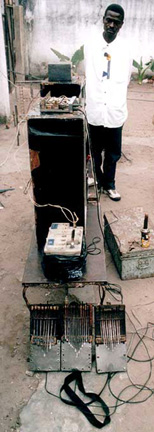
Electrified
likembe of the group Konono N°1 from DRC
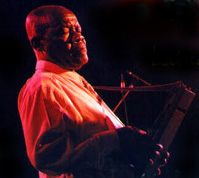
Mawangu
Mingiedi on electrified likembe, of DRC group Konono
N°1
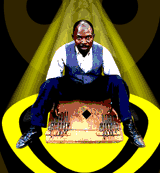
Muyamba
Nyunyi on 20" bass likembe from DRC

Electric
likembe from DRC
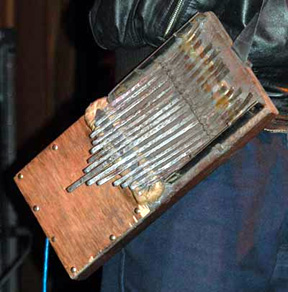
Electric
likembe from DRC
Giant-size, box-shaped
instruments with between four and seven keys attached (8-13
in some modern versions, see Cloud Nine marímbula
with wooden lamellae tuned to circle of fifths pictured
below) appeared all over the Caribbean and parts of South
America as a result of the slave trade. These instruments
were known by several different names (see nomenclature
above) and were used to provide a bass sound in various
musics. Although they have mostly been replaced by the acoustic
bass, some can still be found in Jamaica (for example, in
the mento
music of the Jolly Boys or The Triangles,
among others), Trinidad, Puerto Rico and, occasionally,
Cuba. The earliest surviving recordings were made in Cuba
in 1925 by the bands Terceto Yoyo and Sexteto Habenero,
with Gerardo Martinez and Chucho Aristola, respectively,
on the marímbula. The marímbula
has also been used in modern percussion music compositions
by composers Amadeo Roldan (Two Ritmicas, 1930)
and William Russell (Three Cuban Pieces, 1939).
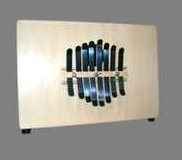
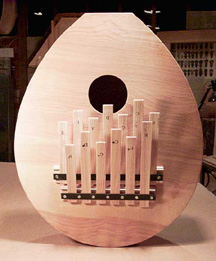
German made
modern marímbula & American Cloud Nine
marímbula
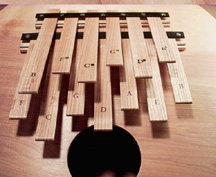
Close up
of Cloud Nine chromatic marímbula
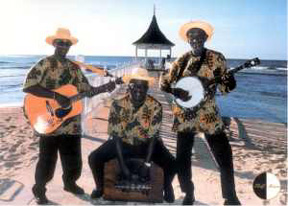
The Triangles
mento group from Jamaica
Even though they are not traditional to
the West, mbira appear in many kinds of popular
music recordings in Europe and the USA, from neo-traditional
African music, blues, jazz and movie/television/radio soundtracks
to Broadway shows and creative "world music."
One of the earliest US recordings to include the instrument
was the recording Drums of Passion by Babatunde
Olatunji in 1959. Olatunji had come from Nigeria to study
in the United States and with the growing trend among African
Americans to promote African awareness, his music became
popular. Olatunji plays a kalimba on this recording,
which features a host of jazz musicians, including Yusef
Lateef. An earlier recording, Kind of Blue by Miles
Davis (1959), is an example of a melodic/harmonic concept
in jazz (modal jazz) inspired by the mbira. In
his autobiography (1989), Davis states that, having been
inspired by African lamellaphone music, he was trying to
limit the scales and chords of his compositions on this
recording in an effort to work in a restricted melodic/harmonic
framework as a lamellaphone does. Another jazz recording,
The African Beat (1962) by Art Blakey and the Afro-Drum
Ensemble (an ensemble of African drummers and African-American
jazz musicians), features Yusef Lateef on the kalimba.
In 1966, the Broadway show Wait a Minim! featured
folk music from southern Africa, with Paul Tracey playing
the mbira (Tracey also appeared on Johnny Carson’s
The Tonight Show, demonstrating the mbira
and several other African instruments). A recording that
features a blend of electronic music and world instruments
by composer Jon Appleton and world jazzman Don Cherry (on
kalimba) is Human Music (1970). Bluesman
Taj Mahal started playing solos on a Hugh Tracey kalimba
in his concerts after first hearing the instrument in a
movie. His recording Recycling the Blues and Other Related
Stuff (1972) features a live solo.
As a novelty device, the instrument made an unusual appearance
in a comedy act by Robert Klein, an example of which is
included on his 1973 recording A Child of the Fifties.
Art music composers have scored for lamellaphones as well
including Lou Harrison in The Music for Violin with
Various Instruments—European, Asian and African
(III. Allegro moderato) (mbira, 1969) and George
Crumb (Hugh Tracey kalimba) in Night of the
Four Moons (1969) and Music for a Summer Evening
(Makrokosmos III) (1974). In jazz fusion, bassist Paul
Jackson played the marimbula with Herbie Hancock
in 1973. With the offshoot group The Headhunters, Jackson
sometimes quoted John Coltrane's "A Love Supreme"
as a bass figure on the marimbula on recordings
such as Survival of the Fittest (1975). Perhaps
the most mainstream use of the instrument occurs in recordings
by the group Earth, Wind & Fire, featuring Maurice White
as one of three percussionists. White also used a Hugh Tracey
kalimba (an early example is on "Kalimba Story"
from Open Our Eyes in 1974), and he was able
to successfully perform fast solos on the instrument and
incorporate it into the body of his ensemble’s music.
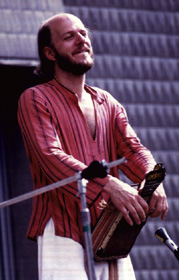
Collin Walcott's Sanza
Style
One of the most creative lamellaphone players
in the United States was the inimitable percussionist/sitarist
Collin Walcott. Walcott played a kondi, which he
referred to generically as "sanza," made
from an insecticide can, which had nine keys and was tuned
to a scale with no third or sixth and a flat seventh in
Western tuning (E-F#-A-B-D-E-F#-A-B from the center, alternating
right to left). His technique was unusual in that he flipped
the instrument over so that the keys faced away from him,
and he plucked with the index, middle and ring fingers of
both hands. He used this instrument first on a recording
of composer Irwin Bazelon’s Propulsions: Concerto
for Percussion (composed/recorded in 1974), then on
the group Oregon’s recording Out of the Woods
(1978) and later on Barry Wedgle’s Kake (1982);
it also featured prominently in many of his compositions
recorded between 1979 and 1983 with the trio Codona (with
Don Cherry and Naná Vasconcelos). Since Walcott’s
death in 1984, one of his students, Rich Goodhart, has perpetuated
the technique and style on his own recordings.
During the 1980s and 1990s, percussionists
such as Adam Rudolph, Glen Velez, Paolo Vinaccia, Layne
Redmond, John Bergamo, Okay Temiz, Rich Goodhart, N. Scott
Robinson, Nexus, Chocolate [Julio Algendones], B. Michael
Williams, Jack DeJohnette, Santiago Vazquez (from Argentina),
Mark Duggan (from
Canada), and Bob Moses used mbira creatively in
their music, as did jazz musicians Ishmael Wadada Leo Smith,
Steve Tibbetts, Egberto Gismonti, Jean-Jacques Avenel and
the Canadian multi-ethnic pop band Ashkaru (with Chip Yarwood
on mbira). Other musicians who play make non-traditional
creative use of various mbira include Virginia
Barrett, Jomo, Armando Ortega (of the Chicano-Shona
influenced band Wagogo),
Billy X. Curmano, and Patrick Hadley, among others. Composers
for Hollywood movies and for radio recordings have used
the lamellaphone creatively on soundtracks as well. One
example is the film Lethal Weapon 2 (1989), with
music by Michael Kamen, which has mbira in the
background music to several scenes. In the 1990s, the nationally
broadcast Talk of the Nation show on National Public
Radio, with theme music by Bob Boilen, a sampled kalimba
was featured prominently with orchestral accompaniment.
Television viewers may be misled by hearing a similar sounding
instrument on an occasional soundtrack to The X-Files
(1990s), with music by Mark Snow, but this is another example
of sampling technology on contemporary keyboards and is
not a real lamellaphone player (keyboards such as the Korg
M-1 featured a kalimba sample as early as 1988).
Conclusion
Organological, technical and timbral diversification
by Western percussionists in popular music was fairly common
after 1960. Lamellaphones were adopted by some musicians
after they had been exposed to African sources either directly
or indirectly through films and recordings. Although lamellaphones
are not so common that players are abundant, Western companies
have continued to construct various types and distribute
them. Although instruments are abundant in the West, their
use in popular music is largely limited to creative percussionists
and other musicians on occasional recordings.
[An edited
version of this article was published as "Mbira (Thumb
Piano)" in the Continuum
Encyclopedia of SPACE SPACE SPACE
Popular Music of the World, Volume 2: Performance
and Production. Edited by John Shepherd,
David Horn, SPACE
SPACE
Dave
Laing, Paul Oliver, and Peter Wicke. New York: Continuum,
2003, 388-394].
Bibliography
Adzenyah, Abraham Kobena
with Dumisani Maraire and Judith Cook Tucker. Let Your
Voice Be Heard! Songs from Ghana SPACE
and Zimbabwe.
New York: World Music Press, 1991.
App, Lawrence J. "Afro-Columbian
Traditions." In The Garland Encyclopedia of World Music:
South America, Mexico, SPACE
SPACE Central America,
and the Caribbean. Edited by Dale A. Olsen and Daniel
E. Sheehy. New York: Garland Publishing, 2, SPACE
1998, 400-412.
Averill, Gage and Lois
Wilcken. "Haiti." In The Garland Encyclopedia of World
Music: South America, Mexico, Central SPACE
SPACE America,
and the Caribbean. Edited by Dale A. Olsen and Daniel
E. Sheehy. New York: Garland Publishing, 2, SPACE
SPACE
1998, 881-895.
Axelsson, Olaf. "Historical Notes
on the Neo-African Church Music." Zambezia
3, no. 2 (1974): 89-102.
________. "Notes on African Musical
Instruments in Zimbabwe." Arts Zimbabwe 2
(1981): 55-62.
Azim, Erica. "Five Mbira Players in
Zimbabwe." Dandemutande 5 (November 1994).
Beach, D. N. "'Chimurenga': the Shona
Rising of 1896-97." Journal of African History
20, no. 3 (1979): 395-420.
Berliner, Paul Franklyn. "The Meaning of the Mbira,
Nyunga-Nyunga." M.A. thesis, Wesleyan University, 1971.
________. "The Soul of Mbira: An Ethnography of the
Mbira Among the Shona People of Rhodesia." Ph.D. diss.,
Wesleyan SPACE University,
1974.
________. "Music and Spirit Possession at a Shona
Bira." African Music Society Journal 5, no.
4 (1975): 130-139.
________. "The Poetic Song Texts Accompanying
the Mbira DzaVadzimu." Ethnomusicology 20,
no. 3 (1976): 451-482.
________. "Political Sentiment in
Shona Song and Oral Literature." Essays in Art
and Science 6, no. 1 (1977): 1-29.
________. "John Kunaka, Mbira Maker."
African Arts 14, no. 1 (1980): 61-67.
________. The Soul of Mbira: Music
and Traditions of the Shona People of Zimbabwe. Chicago:
University of Chicago SPACE
SPACE Press, 1993.
________. The Art of Mbira: Musical Inheritance and Legacy. Chicago: University of Chicago Press, 2019.
Berliner, Paul and Cosmas Magaya. Mbira's Restless Dance: An Archive or Improvisation. Chicago: University of Chicago SPACE Press, 2019.
Bessant, Leslie. "Songs of Chiweshe
and Songs of Zimbabwe." African Affairs 93
(1994): 43-73.
Blacking, John. "Patterns of Nsenga
Kalimba Music." African Music Society Journal
2, no. 4 (1961): 26-43.
Borel, François. Les sanza.
Neuchatel: Musee d'Ethnographie, 1986.
Brandt, Max H. "Venezuela."
In The Garland Encyclopedia of World Music: South America,
Mexico, Central America, and SPACE
the Caribbean.
Edited by Dale A. Olsen and Daniel E. Sheehy. New York:
Garland Publishing, 2, 1998, 523-545.
Brenner, Klaus-Peter.
Chipendani und Mbira: Musikinstrumente, nicht-begriffliche
Mathematik und die Evolution der SPACE
SPACE
harmonischen
Progressionen in der Musik der Shona in Zimbabwe. Gottingen,
Germany: Vandenhoeck & Ruprecht, SPACE
1997.
Brown, Ernest D. "The Guitar and the Mbira: Resilience,
Assimilation, and Pan-Africanism in Zimbabwean Music." The
World SPACE of
Music 36, no. 2 (1994): 73-117.
Burt-Beck, Carol. Playing
the African Mbira. New York: Ludlow Music, 1979.
Cally, Sully. Musiques
et Danses Afro-Caraïbes: Martinique. Gros-Morne, Martinique:
Sully-Cally/Lezin, 1990.
Chawasarira, Chaka. Muridziro
weKarimba naChawasarira. Harare, Zimbabwe: Kunzwana
Trust, 1992 (booklet with SPACE
SPACE cassette).
Chernoff, John Miller.
"The Soul of Mbira Twenty Years On: A Retrospect Part 2."
African Music Society Journal 7, no. 3
SPACE (1996):
91-95.
Chiota, Sekuru and Charles.
The Mbira: Tuning & Plaing Instruction Manual.
Romford: African Crafts Gallery, 2007.
Crauste, Clément.
Kalimba: Un sillon en terre brésilienne.
Paris: Editions De L'Odeon, 2003.
Dampierre, Éric
de. "Sons ainés, sons cadets: les sanza d'Ebezagui."
Revue de Musicologie 68 (1982): 325-329.
Davenport, Peter S. "Form
and Structure in Kondi Music of Northeastern Sierra Leone:
Kututeng Music Among the Limba." SPACE
M.A. thesis,
University of Washington, 1984.
Davis, Miles with Quincy
Troupe. Miles: The Autobiography. New York: Simon
and Schuster, 1989.
Drouet, Héctor Vega. "Puerto
Rico."nIn The Garland Encyclopedia of World Music: South
America, Mexico, Central America, SPACE
and the Caribbean.
Edited by Dale A. Olsen and Daniel E. Sheehy. New York:
Garland Publishing, 2, 1998, 932-941.
Dutiro, Chartwell and
Keith Howard, editors. Zimbabwean Mbira Music on an
International Stage: Chartwell Dutiro's Life in SPACE
Music.
Williston, VT: Ashgate Publishing, 2007.
Gansemans, Jos. "Le
marímbula, un lamellaphone
Africain aux Antilles Neerlandaises." Cahiers de
musiques traditionelles 2 SPACE
(1989): 125-132.
Goddard, Keith. "The
Soul of Mbira Twenty Years On: A Retrospect Part 1."
African Music Society Journal 7, no. 3 (1996):
SPACE 76-90.
Graham, Richard. "The
Giant Lamellaphones: A Global Perspective." Experimental
Musical Instruments 9, no. 12 (1993): SPACE
10-12.
Guilbault, Jocelyne. "Dominica."
In The Garland Encyclopedia of World Music: South America,
Mexico, Central America, SPACE
and the Caribbean.
Edited by Dale A. Olsen and Daniel E. Sheehy. New York:
Garland Publishing, 2, 1998, 840-863.
Holdaway, Mark. Kalimba
Christmas Carols for the Hugh Tracey Alto and Treble Kalimbas.
Tucson: Mark Holdaway, 2005.
________. Kalimba
Fundamentals for the Hugh Tracey Alto Kalimba. Tucson:
Mark Holdaway, 2005.
________. Kalimba
Fundamentals for the Hugh Tracey Treble Kalimba. Tucson:
Mark Holdaway, 2005.
________. The Best
Ever Book of 8-Note Kalimba Music. Tucson: Mark Holdaway,
2006.
________. Playing
the Hugh Tracey Karimba. Tucson: Mark Holdaway, 2006.
________. Playing
the Pentatonic Kalimba. Tucson: Mark Holdaway, 2006.
________. Kalimba
Duets & Trios. Tucson: Mark Holdaway, 2007.
Hornbostel, Erich Moritz
von. "The Ethnology of African Sound-Instruments."
Africa 6, no. 2 (1933): 277 -311.
Howland, Harold. "Master
Percussionist: Oregon's Collin Walcott." Modern Drummer
5, no. 4 (April 1981), 24-26, 39, SPACE
SPACE 64-65, 70.
Hwami, Tendai. Nyungnyunga
Mbira: Scope and Methodology. Harare, Zimbabwe: Tendai
Hwambi, (no date given).
Jones, Arthur Morris. "The Kalimba
of the Lala Tribe, Northern Rhodesia." Africa
20, n. 4 (1950): 324-334.
Jones, Claire. Making Music:
Musical Instruments in Zimbabwe Past and Present. Harare:
Academic Books, 1992.
Julien, Aude. "Practices and Status
of Mbira Players in Venda and Shona Regions (South Africa—Zimbabwe)
XVII-XXI." Ph.D. SPACE
diss., Université
Paris 1—Panthéon-Sorbonne, 2008.
Kaemmer, John E. "Music
of the Shona of Zimbabwe." In The Garland Encyclopedia
of World Music: Africa. Edited by Ruth SPACE
M. Stone. New
York: Garland Publishing, 1, 1998, 744-758.
Kauffman, Robert F. with
Gerhard Kubik, Anthony King, and Peter Cooke. "Lamellaphone."
In The New Grove Dictionary of SPACE
Music and Musicians. Edited by Stanley Sadie.
20 volumes. London: Macmillan Publishers, 10, 1980, 401-407.
Kubik, Gerhard. "Generic Names for
the Mbira; a Contribution to Hugh Tracey's Article 'A Case
for the Name Mbira'." African SPACE
Music Society
Journal 3, no. 3 (1964): 25-36.
________. "Generic Names for the Mbira."
African Music Society Journal 3, no. 4 (1965):
72-73.
________. "Carl Mauch's Mbira Musical
Transcriptions of 1872." Review of Ethnology
3, no. 10 (1971): 1-29.
________. "Likembe Tunings of Kufuna
Kandongan, Angola." African Music Society
Journal 6, no. 1 (1980): 70-88.
________. “Stability and Change in
African Musical Traditions.” The World of Music
28, no. 1 (1986): 44-69.
________. Theory of African Music I.
Wilhelmshaven: Florian Noetzel, 1994 (Intercultural Music
Studies, edited by SPACE
SPACE
Max Peter Baumann;
assistant editor Ulrich Wegner, vol. 7, book with CD).
________. Kalimba, Nsansi, Mbira: Lamellaphone
in Afrika. Berlin: Museum für Völkerkunde,
1998.
________. “African and African American
Lamellophones: History, Typology, Nomenclature, Performers,
and Intracultural SPACE Concepts.”
In Turn Up the Volume! A Celebration of African Music.
Edited by Jacqueline Cogdell DjeDje. Los Angeles: SPACE
UCLA Fowler
Museum of Cultural History, 1999, 20-57, 238, 240-251.
Kubik, Gerhard and Peter Cooke. "Lamellophone."
In The New Grove Dictionary of Music and Musicians.
Edited by Stanley SPACE Sadie.
29 volumes. London: Macmillan Publishers, 14, 2001,
171–181.
Laurenty, Jean-Sébastien. Les
sanza du Congo. Paris: Tervuren, 1962, 2 volumes.
Laviolette, Joel. "Mbira, Matepe,
and Karimba: Various Mbira Types in Zimbabwe." Percussive
Notes 46, no. 5 (October SPACE
SPACE 2008): 43.
Lewin, Olive. "Jamaica."
In The Garland Encyclopedia of World Music: South America,
Mexico, Central America, and the SPACE
Caribbean.
Edited by Dale A. Olsen and Daniel E. Sheehy. New York:
Garland Publishing, 2, 1998, 896-913.
Maraire, Abraham Dumisani.
Mbira Music of Rhodesia. Seattle: University of
Washington Press, 1971 (booklet with cassette).
Maraire, Dumisani Abraham.
The Nyunga Nyunga Mbira: Lesson Book One. Portland:
Swing Trade, 1991.
Mbabi-Katana, Solomon.
The Uganda Likembe: Its History, Tuning Systems, Notational
and Compositional Techniques. SPACE
Kampala, Uganda:
Makerere University Printery, 1986.
McDaniel, Lorna. "Trinidad
and Tobago." In The Garland Encyclopedia of World Music:
South America, Mexico, Central SPACE
America, and
the Caribbean. Edited by Dale A. Olsen and Daniel E.
Sheehy. New York: Garland Publishing, 2, 1998, SPACE
952-967.
Miller, Jeremy. The
Kalimba Book. Denver: Hughes Dulcimer Co., 1977.
Nembire, Katonje Judah
("Mr. Kanga-Fry"). How to Play Zimbabwe’s
Mbira Huru, Using a Very Simple Number Method, SPACE
Staff Notation,
and Tonic Solfa, Distance Education: Step One. Mount
Darwin, Zimbabwe: Nembire School, 1993 SPACE
(booklet with
cassette).
________. How to Play
Zimbabwe’s Mbira Huru, Using a Very Simple Number
Method and a Companion Record: Steps SPACE
One and
Two. Harare: The Zimbabwe Mbira Distance Education
Project (ZIMMDEP), 2000 (booklet with cassette).
Novitski, Paul. "Percussion
Discussion: Embracing Mbira." Rhythm Music 5, no.
8 (1996), 18-22.
Ortiz, Fernando. Le
Marímbula. La Habana,
Cuba: Editorial Letras Cubanas, 1995.
Ottenberg, Simon. Seeing
with Music: The Lives of Three Blind African Musicians.
Seattle: University of Washington Press, SPACE
1996.
Redinha, José.
Instrumentos musicais de Angola: Sua construção
e descrição, notas históricas e etno-sociológicas
da música SPACE Angolana.
Coimbra, Portugal: Instituto de Antropologia, 1984.
Robinson, N. Scott. "Mbira
(Thumb Piano)." In Continuum Encyclopedia of Popular
Music of the World, Volume 2: SPACE
SPACE
Performance
and Production. Edited by John Shepherd, David Horn,
Dave Laing, Paul Oliver, and Peter Wicke. New SPACE
York: Continuum,
2003, 388-394.
________. "BataMbira:
A Marriage of Sacred Music from Cuba and Zimbabwe."
Percussive Notes 5, no. 5 (October 2007): 62.
Rodríguez, Olavo Alén.
"Cuba." In The Garland Encyclopedia of World Music:
South America, Mexico, Central America, and SPACE
the Caribbean.
Edited by Dale A. Olsen and Daniel E. Sheehy. New York:
Garland Publishing, 2, 1998, 822-839.
Rouget, Gilbert. "Note
sur l'accord des sanza d'Ebézagui." Revue
de Musicologie 68 (1982): 330-344.
Santoro, Gene. Stir
It Up: Musical Mixes from Roots to Jazz. New York:
Oxford University Press, 1997.
Sehman, Melanie and Steve
Sehman. "Deconstructing the Mbira." Percussive
Notes 44, no. 5 (Ocotber 2006): 30-31.
Shungu, Djamba Kitende
and Lisala Makodi. "Regard sur la collection des sanza
de l'Institut des Musées Nationaux du Zaïre."
SPACE African
Study Monographs 13, no. 2, (1992): 111-126.
Ssalongo, Christopher
Kizza and Peter Cooke. Teach Yourself the Budongo.
Sutton Coldfield, England: K & C Productions, SPACE
2004.
Theirmann, David. "The
Mbira in Brazil." African Music Society Journal
5, no. 1 (1971): 90-94.
________. "A New
World Mbira: the Caribbean Marímbula."
African Music Society Journal 5, no. 4
(1975/1976): 140-148.
Thieme, Darius L. "Three
Yoruba Members of the Mbira-Sanza Family." Journal
of the International Folk Music Council 19 SPACE
(1967): 42-48.
Thompson, Donald. "The
Marímbula, an Afro-Caribbean Sanza." Yearbook
for Inter-American Musical Research 7 (1971): SPACE
103-116.
Tracey, Andrew. "Mbira
Music of Jege A. Tapera." African Music Society
Journal 2, no. 4 (1961): 44-63.
________. "Three
Tunes for 'Mbira dza vadzimu'." African Music Society
Journal 3, no. 2 (1963): 23-26.
________. "The Mbira
Class of Instruments in Rhodesia (1932)." African
Music Society Journal 4, no. 3 (1969): 78-95.
________. "The Tuning of Mbira Reeds: A Contribution
to the Craft of Mbira Making." African Music
Society Journal 4, no. 3 SPACE
(1969): 96-100.
________. How to Play
the Mbira (dza vadzimu). Roodepoort, Transvaal: International
Library of African Music, 1970.
________. "The Matepe
Mbira Music of Rhodesia." African Music Society
Journal 4, no. 4 (1970): 37-61.
________. "The Original
African Mbira?" African Music Society
Journal 5, no. 2 (1972): 85-104.
________. "The Family
of Mbira: The Evidence of Tuning Plans." Zambezia
3, no. 2 (1974) 1-10.
Tracey, Hugh T. "A
Case for the Name Mbira." African Music 2,
no. 4 (1961): 17-25.
________. A New Musical
Instrument from Africa. Roodepoort, Transvaal: African
Musical Instruments, 1967.
________. "The Mbira
Class of African Instruments in Rhodesia (1932)."African
Music Society Journal 4, no. 3 (1969): 78-95.
Turino, Thomas. "The Mbira,
Worldbeat, and the International Imagination." The World
of Music 40, no. 2 (1998): 85-106.
________. Nationalists,
Cosmopolitans, and Popular Music in Zimbabwe. Chicago:
University of Chicago Press, 2000.
Udow, Michael W. "African
Percussion Music." Percussionist 9, no. 4 (1972):
119-128.
van Oven, Cootje. "Letters
to the Editor." African Music 3, no. 1 (1962):
112.
________. "The Kondi
of Sierra Leone." African Music Society
Journal 5, no. 3 (1973/1974): 77-85.
Williams, B. Michael.
"Getting Started with Mbira dza Vadzimu." Percussive
Notes 35, no. 4 (1997): 38-49.
________. Learning
Mbira: A Beginning. . . . Everett: HoneyRock, 2001.
Discography
African
Azim, Erica Kundidzora. CD. Mbira Dreams: Trance
Music of Zimbabwe. The Relaxation Company CD3261. 1996:
USA. SPACE (Erica
Kundidzora Azim-mbira dza vadzimu).
Bebey, Francis. LP. Africa
Sanza. Makossa ADSC-11-86015. 1982: USA. (Francis
Bebey-sanza).
________. LP. Akwaaba:
Music for Sanza. Original Music OMA 105. 1984: USA.
(Francis Bebey-sanza).
________. CD. Didiye.
Pee Wee Music PW 017. 1997: France. (Francis Bebey-sanza).
Berliner, Paul F. CD. The
Soul of Mbira: Traditions of the Shona People of Rhodesia. Nonesuch
H-72054. 1973: USA. SPACE(Various
artists-various Shona mbira).
________. LP. Africa:
Shona Mbira Music. Nonesuch H-72077. 1977: USA. (Various
artists-various Shona mbira).
Chawasarira, Chaka. Cassette.
Solo Matepe and Vocals. Mbira 303. 2000: USA. (Chaka
Chawasarira-matepe).
________. CD. Magore
Kore. Mhumhi Records (no #). 2001: USA. (Chaka Chawasari-matepe
& 19-lamellae karimba).
Chiweshe, Stella Rambisai
[Stella Nekati-Chiweshe]. CD. Kumusha. Piranha
Pir 42-2. 1990: Germany. (Stella Rambisai SPACEChiweshe-mbira
dza vadzimu).
Gora, Sekuru (Thomas Wadharwa)
with Tute Chigamba & Moyo. CD. Vakuru Chaivo.
Mhumi Records (no #). 2001: USA. SPACE(Thomas
Wadharwa a.k.a. Sekura Gora & Tute Chigamba-mbira
in dongonda & mavembe tunings).
Gwara, Newton and the
Nheravauya Mbira Group. CD. Nhengure. Mhumi Records
(no #). 2001: USA. (Newton Gwara a.k.a. SPAC
SMatemai-mbira).
Gweshe, David. CD. Mhuri
YeKwaNohoreka. Mhumhi Records (no #). 2001: USA. (David
Gweshe-munyonga).
Khoza, Valanga. CD. The
Journey. Mabuhay World Music MBR 00013. 1997: Australia.
(Valanga Khoza-kalimba).
Konono N°1. CD. Orchestre
Tout Puissant Likembe Konono No. 1 de Mingiedi: Lubuaku.
Terp African Series AS09. 2004: SPACEHolland.
(Mingiedi Mawangu-electrified lead likembe, Makuntima
Mawangu-2nd electrified likembe, Kabuika SPACE
SPACENsekula-electrified
bass likembe & Kuavita Nzimbu-electrified likembe).
________. CD. Congotronics.
Crammed Discs CRAW 27. 2004: Belgium. (Mawangu Mingiedi
& others-electrified likembe).
Koufoudila, Boniface.
LP. Kasongo! Modern Music of the Belgian Congo.
Capitol T-10005. 1955: USA. (Boniface SPACE
SPACE
SPACEKoufoudila-likembe).
Kunzwana Mbira Group.
CD. Shamu YaPasi. Mhumi Records (no #). 2000: USA.
(Judith Juma & Rhoda Dzomba-mbira dza SPACE
vadzimu).
Mapfumo, Thomas and The
Blacks Unlimited. CD. Shumba: Vital Hits of Zimbabwe. Virgin
3-1022-1. 1990: USA. (Contains SPACE
the Shona mbira
dza vadzimu piece "Taireva" performed on electric guitars).
________. CD. Chimurenga
'98. Anonym 0001. 1999: USA. (mbira dza vadzimu).
Maraire, Abraham Dumisani.
LP. African Story: Songs Told and Sung by Abraham Dumisani
Maraire. University SPACE
SPACE
of Washington
Press (no number). 1969: USA. (Abraham Dumisani Maraire-karimba).
Maraire, Dumisani and
Ephat Mujuru. CD. Shona Spirit. Music of the World
CDT-136. 1996: USA. (Dumisani SPACE
SPACE
SPACE
Maraire-karimba
and Ephat Mujuru-mbira dza vadzimu).
Mashoko, Sekuru Simon.
CD. Hallelujah. Mhumi Records (no #). 2001: USA.
(Sekuru Simon Mashoko-njari).
Mashozhera Mbira Group.
CD. Hurombo. Mhumi Records (no #). 2001: USA. (Victor
Matanga-gandanga tuned mbira).
Mbira DzeNharira. CD.
Kudya KweNzeve. Mhumi Records (no #). 2001: USA.
( Mbira DzeNharira-7-piece mbira orchestra).
Moundanda, Antoine &
Likembé Géant. CD. Kesse Kesse. Indigo
LBLC 2541. 1997: France. (Antoine Moundanda & Likembé
SPACE Géant-likembe).
Olatunji, Babatunde. CD.
Drums of Passion. Columbia CK 8210. 1960: USA.
(Babatunde Olatunji-kalimba).
Samite of Uganda. CD.
Dance My Children Dance. Shanachie 65003. 1988:
USA. (Samite Mulondo-kalimba, finger piano).
Suso, Fody Musa. CD. The
Dreamtime. CMP CD 3001. 1990: Germany. (Foday Musa
Suso-kalimba).
Tchakounté, Pierre
Didy. CD. Best of Pierre Didy Tchakounté Golden
Collection Vol. 1: Magabe Sophistiqué-Versions SPACE
SPACE
Originales.
Ngumsam Records [no #, no date]. Mid-1970s. (Pierre Didy
Tchakounté-sanza).
________. CD. The
King of Mangambeu in U.S.A.: La Consécration Vol.
1. Simba Music [no#, no date]. Mid-1970s. (Pierre SPACE
Didy Tchakounté-sanza).
Tirikoti, Garikayi. CD.
Maidei. Limitless Sky Records GT0603. 2001: USA.
(Garikayi Tirikoti & Lee Kumbani-mbira dza SPACE
SPACE
vadzimu).
Tracey, Andrew and Paul
Tracey with Nigel Pegram. LP. Wait a Minim! London
AM 58002. 1966: USA. (Paul SPACE
SPACE
SPACE
Tracey-kalimba).
Tracey, Hugh. LP. Reeds
(Mbira) 1: The Music of Africa Series v. 28-Musical Instruments
2. Gallatone GALP 1323. 1960: SPACE
South Africa.
(Examples of various lamellaphones in traditional African
settings-various players).
________. CD. Other
Musics from Zimbabwe, Southern Rhodesia, 1948, '49, '51,
'57, '58, '63. SWP Records SWP 012/HT 06. SPACE
1948-1963:
The Netherlands. (Examples of various players of matepe,
mbira dza vaNdau, and mbira njari from
SPACE SPACE
Zimbabwe).
________. CD. Northern
and Central Malawi, Nyasaland, 1950, '57' 58. SWP Records
SWP 014. 1950/1957/1958: The SPACE
SPACE
Netherlands.
(Examples of various players of kalimba from Malawi).
________. CD. Kalimba
& Kalumbu Songs, Northern Rhodesia, Zambia 1952 &
1957. SWP Records SWP 010. 1952/1957: The SPACE
Netherlands.
(Examples of various lamellaphones from Zambia).
Various Artists. CD. Southern
Mozambique, Portuguese East Africa, 1943, '49, '54, '55,
'57, 63. SWP Records SWP 021. SPACE
SPACE
1943-1963:
The Netherlands. (Examples of various mbira from
Mozambique).
________. CD. Tanzania
Instruments, 1950. SWP Records SWP 022. 1950: The Netherlands.
(Examples of various likembe SPACE
from Tanzania).
________. CD. Secular
Music from Uganda, 1950 & 1952. SWP Records SWP
024. 1950/1952: The Netherlands. (Examples of SPACE
various likembe
from Uganda).
________. CD. Forest
Music, Northern Belgian Congo, 1952. SWP Records SWP
016. 1952: The Netherlands. (Examples of SPACE
various Mangbetu
players of likembe from Congo).
________. CD. Zair:
Musiques Urbaines á Kinshasa. Ocora CSS9007HM65. 1978:
France. (Features the Orchestre Bana SPACE
Luya on electrified
likembe).
________. CD. Central
Africa: Sanza Music in the Land of the Gbaya. VDE CD-755.
1993: Switzerland. (Various Gbaya SPACE
People-sanza).
________. CD. Traditional
Music of Cancune, Mozambique: ChiSanza & Nyanga dzeCancune.
Mhumhi Records (no #). SPACE 2001: USA. (Simoes
John Pemba-ChiSanza).
________. CD. Mbira
DzaVaNdau: From Chimanimani to Birchenaugh Bridge.
Mhumi Records (no #). 2003: USA. (Various SPACE
Ndau musicians-mbira
dza vaNdau).
________. CD & DVD.
Congotronics 2: Buzz 'n' Rumble from the Urb 'n' Jungle.
Crammed Discs CRAW 29. 2006: Belgium. SPACE
(Various ensembles
from Democratic Republic of Congo on acoustic & electrified
likembes).
Zawose, Hukwe Ubi. CD. Tanzania—The
Art of Hukwe Ubi Zawose: Songs Accompanied by Ilimbe and
Izeze. JVC SPACE SPACE
VIGC-5011-2. 1989:
Japan. (Hukwe Ubi Zawose-ilimba).
________. CD. Chibite.
Real World CAROL 2358-2. 1996: USA. (Hukwe Ubi Zawose &
Charles Zawose-ilimbas).
Zawose, Dr. Hukwe &
Charles Zawose. CD. Mkuki Wa Roho: "A Spear To
the Soul". Womad 407-C. 2000: USA. (Hukwe SPACE
SPACE Zawose &
Charles Zawose-ilimbas).
Zawose, Hukwe Ubi and
Michael Brook. CD. (Assembly). Real World 7243
8 12296 2. 2002: USA. (Hukwe Zawose & Charles SPACE
Zawose-ilimbas).
Zengea Karimba Ensemble,
The. CD. Vadzimuwe. ABF Skane ABFSK001. 1992: Sweden.
(Tschaka Chawasarira & Zengea SPACE
Karimba Ensemble-karimba).
African Diaspora
Chocolate (Julio Algendones). CD. Chocolate: Peru’s
Master Percussionist. Lyrichord LYRCD 7417. 1990: USA.
SPACE SPACE SPACE
(Chocolate-Julio Algendones-kalimba).
Jolly Boys. CD. Sunshine
‘n Water. Rykodisc RCD 10187. 1991: USA. (Joseph Bennett-rhumba
box).
Lititz Mento Band. CD.
Dance Music and Working Songs from Jamaica. Haus
Der Kulturen Der Welt SM 1512-2. 1992: SPACE
SPACE
Germany. (Cleveland Salmon-rhumba box).
Sexteto Habenero. 78 LP.
Loma De Belen. Victor 594. 1925: Cuba. (Chucho
Aristola-marímbula).
Terceto Yoyo. 78 LP. El
Congrejito. Victor 578. 1925: Cuba. (Gerardo Martinez-marímbula).
Various Artists. CD. Hot
Music from Cuba: 1907-1936. Harlequin HQCD-23. 1993:
England. (Features both of the Cuban 78s SPACE
in this discography-Chucho
Aristola & Gerardo Martinez-marímbula).
________. LP. Musik
från Västindien: Små Antillerna (Music from the West Indies:
The Lesser Antilles). Compiled by SPACE
SPACE Krister Malm. Caprice
CAP 2004. 1977: Sweden. (Features Trinidadian parang
music with unidentified marímbula
SPACE player).
________. CD. Burundi:
Musiques Traditionnelles. Ocora Radio France C 559003.
1988: France. (Features music from SPACE
Burundi with
sanza).
Western Art & Popular
Music
Alfano, Jorge. CD. One Heart. Lyrichord
7431. 1997: USA. (Randy Crafton-mbira).
Ancient Future. CD. Dreamchaser.
Narada 62754. 1988: USA. (Ian Dogole-kalimba).
Anders, Robin Adnan. CD.
Omaiya. Rykodisc RCD 10442. 1999: USA. (Robin
Adnan Anders-mbira).
Andersen, Arild. CD. Arv.
Kirkelig Kulturverksted FXCD 133. 1994: Norway. (Paolo Vinaccia-large
sanza).
Appleton, Jon and Don
Cherry. LP. Human Music. Flying Dutchman FDS 121.
1970: USA. (Don Cherry-kalimba).
Ashkaru. CD. Mother
Tongue. Triloka 7214. 1995: Canada. (Chip Yarwood-mbira).
Asza. CD. Asza.
Pacific Line Music PM0410CD. 1995: Canada. (Joseph "Pepe"
Danza-mbira).
Bandt, Ros. CD. Stargazer.
Vox Australis VAST 004-2. 1989: Australia. (Ros Bandt-kalimba).
Bazelon, Irwin. CD. Music
of Irwin Bazelon. CRi American Masters CD 623. 1992:
USA. (Collin Walcott-sanza).
Berliner with Kudu, Paul.
LP. The Sun Rises Late Here. Flying Fish 092. 1977:
USA. (Paul Berliner-mbira dza vadzimu).
Blakey, Art and the Afro-Drum
Ensemble. LP. The African Beat. Blue Note BST-84097.
1962: USA. (Yusef Lateef-kalimba).
Bloque. CD. Bloque.
Warner Bros. 9 47060-2. 1998: USA. (keyboard kalimba
sample).
Bridges. CD. Bridges. Interworld
921. 1996: USA. (Randy Crafton-kalimba).
Codona. CD. Codona.
ECM 1132 78118-21132-2. 1979: USA. (Collin Walcott-sanza).
________. CD. Codona
2. ECM 1177 78118-21177-2. 1981: USA. (Collin Walcott-sanza).
________. CD. Codona
3. ECM 1243 78118-21243-2. 1983: USA. (Collin Walcott-sanza).
Crafton, Randy. CD. Duologue.
Lyrichord LYRCD 7430. 1997: USA. (Randy Crafton-mbira).
Crandell, Richard. CD.
Mbira Magic. Tzadik 8005. 2004: USA. (Richard Crandell-mbira).
Crumb, George. LP. Music
for a Summer Evening (Makrokosmos III). Nonesuch H-
71311. 1975: USA. (Gilbert Kalish-Hugh SPACE
Tracey kalimba).
Dalglish, Malcolm. CD. Pleasure.
Ooolitic Music OM 1112. 1997: USA. (N. Scott Robinson-sanza).
Davis, Miles. CD. Kind
of Blue. Columbia Legacy CK 64935. 1959: USA.
Deadline. CD. Down
By Law. Celluloid CELCD 6111. 1985: USA. (Phillip Wilson-kalimba).
Dietrichson, Tor. CD. Global
Village. Global Pacific R2-79302. 1987: USA. (Kim Atkinson-mbira).
Do'ah. CD. Companions
to the Crimson Coloured Ark. Philo CD-PH-9009. 1986:
USA. (Randy Armstrong and Ken SPACE
SPACE
LaRoche-Shona
mbira).
________. CD. World
Dance. Global Pacific R2 79304. 1988: USA. (Randy Armstrong
and Ken LaRoche-Shona mbira).
Earth, Wind & Fire. CD.
Open Our Eyes. Columbia/Legacy 61615. 1974. (Maurice
White-Hugh Tracey kalimba).
________. CD. Spirit.
Columbia CBS CK 34241. 1976: USA. (Maurice White-Hugh Tracey
kalimba).
________. CD. I Am.
Columbia CK 35730. 1979: USA. (Maurice White-Hugh Tracey
kalimba).
________. LP. Faces.
ARC/Columbia KC2 36595. 1980: USA. (Maurice White-Hugh Tracey
kalimba).
________. CD. Powerlight.
CBS CK 38367. 1983: USA. (Maurice White-Hugh Tracey
kalimba).
Eliovson, Steve and Collin
Walcott. CD. Dawn Dance. ECM 1198 829 375-2. 1981:
USA. (Collin Walcott-sanza).
Entourage and Theatre
Ensemble, The. LP. Entourage. Folkways FTS
33866. 1973: USA. (lamellaphone).
Gioielli, Décio.
CD. Kalimba. Dandemutande 355-C. 2001: Brazil.
(Décio Gioielli-Hugh Tracey kalimba).
Gismonti, Egberto. CD.
Sol do meio dia. ECM 1116 78118-21116-2. 1978:
USA. (Egberto Gismonti-kalimba).
Goodhart, Rich. CD.
Divining Signs. Beginner’s Mind Productions BMP
1001. 1988: USA. (Rich Goodhart-sanza).
________. CD. Affirmative
Reply. Beginner’s Mind Productions BMP 1002. 1991:
USA. (Rich Goodhart-sanza).
________. CD. Never
Give a Sword to a Man Who Can’t Dance. Beginner’s Mind
Productions BMP 0403. 1995: USA. SPACE
SPACE
(Rich Goodhart-sanza).
Hadley, Patrick. CD. EgyptiCat.
Abracadabra Music Corporation [# unknown]. 2001: USA. (Patrick
Hadley-5 octave array SPACE
mbira).
Hancock, Herbie. CD. Head
Hunters. Columbia/Legacy 471239 2. 1973: USA. (Paul
Jackson-marimbula).
Harrison, Lou. CD.
The Music of Lou Harrison. Phoenix PHCD 118. 1971:
USA. (Kenyan mbira quartet).
Headhunters, The. CD.
Survival of the Fittest. RCA 74321409522. 1975:
USA. (Paul Jackson-marimbula).
Heap, Imogen. CD. Speak
for Yourself. RCA 72532. 2005: England. (Imogen Heap-array
mbira on the song "Clear the Area").
Hermann, Ralph. CD. Kalimba—Acid
Wav Riff Audio. Forwardinoutback SF2. 2004: Europe.
(Ralph Hermann-kalimba SPACE
SPACE samples).
Holdaway, Mark. CD. Two
Thumbs Up: Adventures on the African Kalimba. Mark
Holdaway CD001, 2000.
________. CD. Christmas
Kalimba. Mark Holdaway CD002, 2005.
Holland,
Mark & N. Scott Robinson. Wind & Fire.
CD, Cedar n Sage Music CS 7514. 2009: USA. (N. Scott Robinson-sanza,
SPACE mbira
dza vadzimu).
________.
Lost In The Beauty Of It All. CD, Cedar n Sage
Music CS 7517. 2013: USA. (N. Scott Robinson-Dongonda
mbira SPACE dza
vadzimu,
Dambatsoko mbira dza vadzimu, kalimba).
Hooker, John Lee. CD.
Free Beer and Chicken. Beat Goes On BGO CD123.
1974: USA. (Unidentified musician-kalimba).
Kaiser, Henry and David
Lindley. CD. Sweet Sunny North: Henry Kaiser & David
Lindley in Norway v. 1. Shanachie 640-57. SPACE
1994: USA.
(Paolo Vinaccia-large sanza).
King Crimson. CD. Larks'
Tongues in Aspic. EG EGCD-7. 1973: USA. (Jamie
Muir-kalimba).
Klein, Robert. CD.
A Child of the Fifties. Rhino R4 70769. 1973: USA.
(Robert Klein-kalimba).
Klug, Slats and Friends.
CD. Lies and Love Songs. Rebo Music 132027. 2003:
USA. (N. Scott Robinson-sanza).
Mahal, Taj. CD. Recycling
the Blues and Other Related Stuff. Mobil Fidelity Sound
Lab MFCD764. 1972: USA. (Taj SPACE
SPACE
Mahal-Hugh
Tracey kalimba).
Moses, Bob. CD. Time
Stood Still. Gramavision R2 79493. 1994: USA. (Bob
Moses-mbira).
Moye, Famoudou Don. LP.
Sun Percussion Volume One. Aeco 001. 1975: USA.
(Don Moye-kalimba).
Nakai, R. Carlos and Wind
Travelin' Band with Shonosuke Ohkura and Oki Kano. CD. Island
of Bows. Canyon CR-7018. 1994: SPACE
USA. (ESOH-kalimba).
Nauseef, Mark. LP. Personal
Note. CMP 16. 1981: Germany. (Mark Nauseef-kalimba).
________. CD. Wun-Wun.
CMP CD 25. 1992: Germany. (Mark Nauseef-mbira).
Oregon. CD. Out of
the Woods. Discovery 71004. 1978: USA. (Collin Walcott-sanza).
________. CD. Roots
in the Sky. Discovery 71005. 1979: USA. (Collin Walcott-sanza).
________. CD. Oregon
in Performance. Wounded Bird 304. 1980: USA. (Collin
Walcott-sanza).
Ottopasuuna. CD. Ottopasuuna.
Green Linnet GLCD 4005. 1992: Finland. (Kimmo Pohjonem-Gogo
marimba).
Redmond, Layne and The
Mob of Angels. CD. Since the Beginning. Redmond
Recordings RRCD11. 1992: USA. (Layne SPACE
SPACE
Redmond-mbira).
Reid, Sandra. CD. Hal-An-Tow:
Songs of Six Nations. Lyrichord 7425. 1995: USA. (Randy
Crafton-kalimba).
Reijseger, Ernst and Michael
Moore. LP. Cellotape & Scotchtape. Data 822. 1982:
Holland. (Ernst Reijseger-kalimba).
Robinson, N. Scott. CD. World View.
United One Records U1CD 402 4569 3027 2/New World View Music
NWVM CD-01. SPACE 1994:
USA/Germany. (N. Scott Robinson-sanza, bass sanza).
________. CD. Things That Happen Fast.
New World View Music NWVM CD-02. 2001: USA. (N. Scott Robinson-karimba
SPACE and
Nolan Warden-karimba).
Rudolph, Adam and Moving
Pictures. CD. Skyway. Soulnote 121269. 1994: USA.
(Adam Rudolph-kalimba).
________. CD. Contemplations.
Meta Records META 002. 1997: USA. (Adam Rudolph-kalimba).
Sanders, Pharoah. CD.
Save Our Children. Verve 557 297-2. 1998: USA.
(Zakir Hussain-array mbira).
Santana. CD. Welcome.
Columbia 16142. 1973: USA. (Richard Kermode-kalimba).
Shadowfax. CD. Too
Far to Whisper. Windham Hill WD-1051. 1977: USA. (G.E.
Stinson-mbira).
________. CD. The
Odd Get Even. Atlantic 20652P. 1990: USA. (G.E. Stinson-mbira).
Simon, Ralph. CD. As.
Postcards POST 1004. 1981: USA. (Gene Adler-kalimba).
Smith, Ishmael Wadada
Leo. CD. Kulture Jazz. ECM 1507. 1993: USA. (Ishmael
Wadada Leo Smith-kalimba).
3 Mustaphas 3. CD. Heart
of Uncle. Rykodisc RCD 20156. 1989: USA. (Hijaz Mustapha-mbira).
Tibbetts, Steve. CD. Exploded
View. ECM 1335 831 109-2. 1986: USA. (Steve Tibbetts-kalimba).
ToKenKi. CD. Dance
Latitude. TKM 2001. 1991: USA. (Kim Atkinson-kalimba).
Various Artists. CD. Live
at the Knitting Factory, vol. 2. Knitting Factory Works
KFWCD-98. 1989: USA (N. Scott SPACE
SPACE Robinson-mbira).
________. LP. Concert
Percussion for Orchestra. Time Records S/8000 (features
recordings of the pieces by Amadeo Roldan SPACE
and William
Russell). 1961: USA (George Boberg-marímbula).
Vazquez, Santiago. CD.
Mbira Y Pampa. Musical Antiatlas Producciones MAP
178. 2005: Argentina (Santiago Vazquez-mbira SPACE
dza vadzimu).
Velez, Glen. CD. Handance.
Nomad NMD 50301. 1985: USA (Glen Velez-mbira dza
vadzimu).
________. CD. Seven
Heaven. CMP CD 30. 1987: Germany. (Glen Velez-mbira
dza vadzimu, mbira & Layne SPACE
SPACERedmond-mbira).
________. CD. Border
States. Interworld CD-21907. 1993: USA. (Glen Velez
& Randy Crafton-kalimba).
________. CD. Rhythmcolor
Exotica. Ellipsis Arts CD 4140. 1996: USA. (Jan Hagiwara-mbira).
Weather Report. CD. Weather
Report. Columbia/Legacy CK-48824. 1971: USA. (Airto
Moreira-kalimba).
Wedgle, Barry. CD. Kake.
Wonderful World Records 1201-2. 1982: USA. (Collin Walcott-sanza).
Whelan, John. CD. Flirting
with the Edge. Narada 45444. 1998: USA. (Samite Mulondo-kalimba).
Videography
Belafonte, Harry. Roots of Rhythm.
1989. Docurama NVG-9476 (DVD). (Marimbula).
Chiweshe, Stella Nekati. Music of the
Spirits: The Mbira Music of Stella Chiweshe. 1989.
Ron Hallis & Ophera Hallis (DVD). SPACE
(Stella Nekati
Chiweshe-Shona mbira).
Corea, Chic. The Ultimate Adventure:
Live in Barcelona. 2007. Concord (DVD). (Ruben Dantas-kalimba).
Dzamwarira, Thomas. Mbira Matepe dza
Mhondoro: A Healing Party. 1975. Pennsylvania State
University (video). (Matepe).
Donner, Richard (director). Lethal
Weapon 2. 1989. (Sampled lamellaphones in video soundtrack).
Earth, Wind & Fire. Earth,
Wind & Fire Live in Japan '90. 1990. Pioneer Artists
PA- 98-582D (video). (Maurice SPACE
SPACE
SPACE White-kalimba).
________. Earth,
Wind & Fire Live. 1994. PolyGram Video 800 635
727-3 (video). (Maurice White-kalimba).
Gates, Jr., Henry Louis.
Wonders of the African World: 3-The Slave Kingdoms.
1999. PBS B8103 (DVD). (Aprempensuah).
Gwenzi, Gwanzura. Mbira dza Vadzimu: Religion at the
Family Level with Gwanzura Gwenzi. 1975. Pennsylvania
State SPACEUniversity
(video). (Shona mbira dza vadzimu).
Hadouk Trio. En Concert au Satellit Café.
2004. Naïve NV 802611 (DVD). (Loy Ehrlich-sanza).
Kwenda, Forward. Muridziro we Forward Kwenda: Advanced
Mbira Tutorial. 1995. Dandemutande (video). (Shona
mbira SPACE dza
vadzimu).
Mashoko, Simon. Mbira: Njari-Karanga Songs in Christian
Ceremonies with Simon Mashoko. 1975. Pennsylvania State
SPACEUniversity (video).
(Shona mbira).
Mbira dzeNharira. Rwendo Rwekure: The Journey of a
Thousand Miles. 2001. ZMC ZMVD 03 (video). (Shona mbira).
Mude, Hakurotwi. Mbira
dza Vadzimu: Urban and Rural Ceremonies. 1978. Pennsylvania
State University (video). SPACE
SPACE
(Hakurotwi
Mude-mbira dza vadzimu).
Mujuru, Ephat. Mbira:
The Technique of the Mbira dza Vadzimu. 1975.
Pennsylvania State University (video). (Ephat SPACE
SPACE
Mujuru-mbira
dza vadzimu).
Mujuru, Muchatera and
Ephat Mujuru. Mibra dza Vadzimu: Dambatsoko—An
Old Cult Center with Muchatera and Ephat SPACE
Mujuru.
1975. Pennsylvania State University (video). (Shona mbira).
Robinson, N. Scott. Hand
Drumming: Exercises for Unifying Technique. 1996. Wright
Hand Drum Company WHD-001 SPACE
SPACE
(video). (N. Scott Robinson-sanza).
Sandler, Patricia. The
Mbira and the Music of the Shona People of Zimbabwe. 1994.
Percussive Arts Society PAS9422 SPACE
SPACE
(video). (Patricia
Sandler-mbira dza vadzimu).
Various Artists. Konkombe:
The Nigerian Pop Music Scene. 1980. Shanachie (video).
(Example of Nigerian lamellaphone).
________. Kalimba
Demonstration Video. (no date given). African Musical
Instruments (video).
________. The JVC
Video Anthology of World Music and Dance vol. 17-Middle
East & Africa II: SPACE SPACE
SPACE
SPACE
Egypt/Tunisia/Morocco/Mali/Cameroon/Zaire/Tanzania.
1988. JVC, Victor Company of Japan (video). (Example
SPACE from
Cameroon of the Fulhe People-sanza).
________. The JVC
Video Anthology of World Music and Dance vol. 19-Middle
East & Africa IV: Ivory SPACE
SPACE
SPACE
Coast/Botswana/Republic
of South Africa. 1988. JVC, Victor Company of
Japan (video). (Example from Botswana of SPACE
the San Bushmen-lamellaphone).
________. Mbira Music:
The Spirit of the People (The Spirit of Zimbabwe). 1990.
Films for the Humanities & Sciences SPACE
(video). (Various
Shona, including Stella Rambisai Chiweshe, on various Shona
mbira).
________. The JVC/Smithsonian
Folkways Video Anthology of Music and Dance of Africa vol.
2: The SPACE SPACE
SPACE
SPACE
Gambia/Liberia/Ghana/Nigeria.
1996. JVC, Victor Company of Japan (video). (Example
of lamellaphone from SPACE
Liberia).
________. Cuban Music:
Musicos Legendarios de La Habana Vieja. 1999. Charles
A. Becker/Maní (video). (Example of SPACE
marímbula).
________. Congotronics
2: Buzz 'n' Rumble from the Urb 'n' Jungle. Crammed
Discs CRAW 29 (DVD & CD). 2006: Belgium. SPACE
(Various ensembles
from Democratic Republic of Congo on acoustic & electrified
likembes).
Wemba, Papa. La
ville est belle [Life is Rosy]. 1987. Lamy Films
(video). (Papa Wemba-likembe).
Wesley, Bill and Patrick
Hadley. The Array Mbira. 2004. Array Instruments
(DVD). (Bill Wesley & Patrick Hadely-array SPACE
SPACE mbira).
©2004 - N. Scott Robinson.
All rights reserved. |

